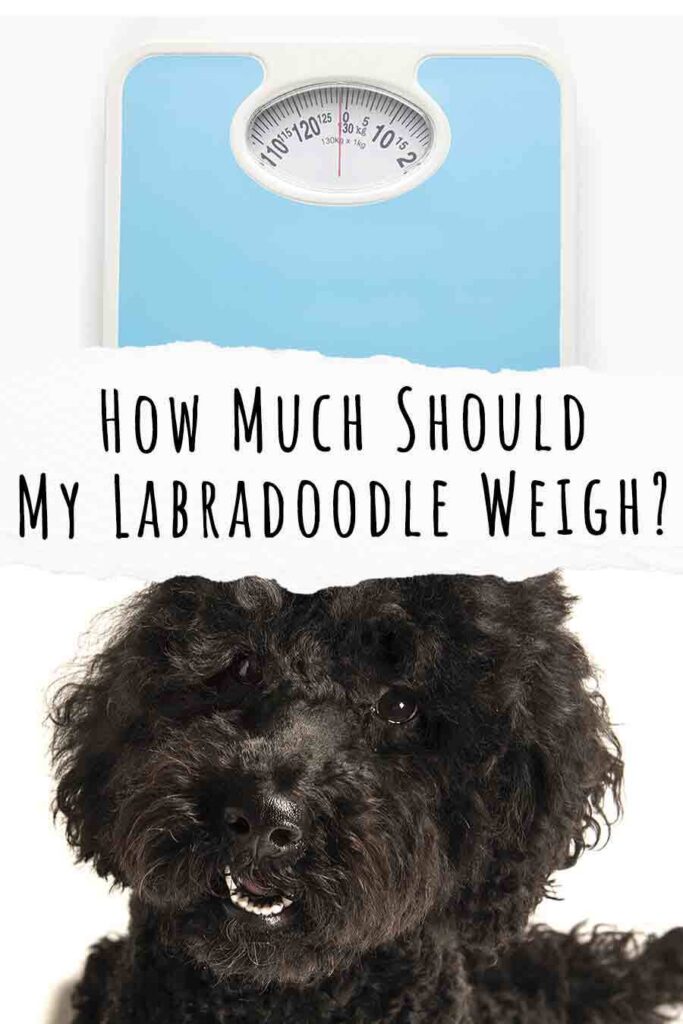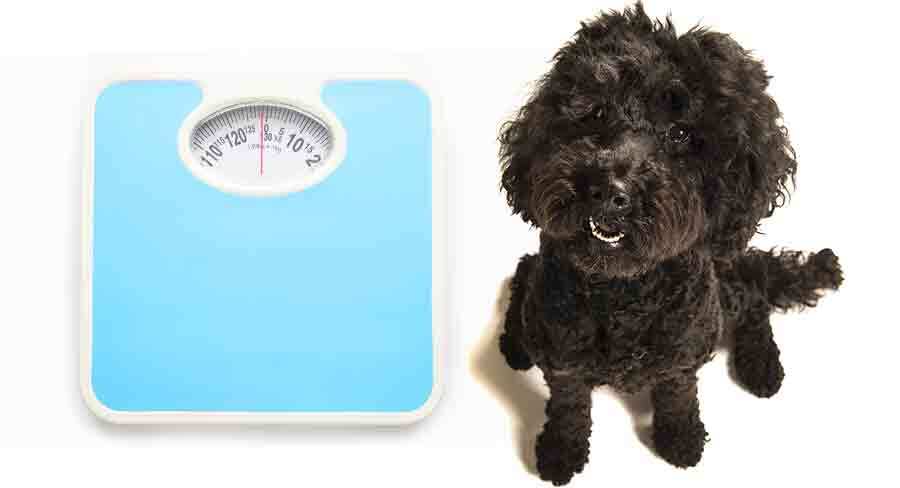Labradoodle size and weight can vary hugely. Not just down to differences in their diet or exercise, but due to the varying sizes of Poodles used to breed Labradoodles. Healthy Labradoodles can weigh less than 30lbs, or more than 70lbs!
Factors which account for this massive range include parentage, sex, and overall health. It’s important to monitor Labradoodle puppy growth, and their adult size, to make sure it stays within healthy parameters.
- Your Puppy’s Parents
- Labradoodle Size and Weight vs Body Condition
- Is My Doodle Underweight?
- Normal Weight Labradoodles
- Is My Labradoodle Overweight?
Labradoodle Size and Weight
Labradoodles are among the most popular mixed breed dogs. A cross between the Labrador Retriever and a Poodle, Labradoodle fans hope their dog will combine the best qualities from both breeds. Before they bring a Doodle home, they usually want to know how big it is likely to get. And once their puppy has arrived, they’re anxious to know whether it is growing as it should.
But the adult size of any puppy can be hard to predict, especially when it comes to mixed breed dogs. Mixed breed dogs like the Labradoodle can inherit a combination of characteristics from both parent breeds, including size.

Weighing Up The Labradoodle
Labradoodle adult weight can be especially hard to predict because their Poodle parent comes in three sizes: Standard, Miniature, and Toy. It is common for Labradoodles to be labelled as either standard or miniature, depending on the size of the Poodle parent. Some breeders distinguish between these an intermediate “medium” size too.
Furthermore, weight guides for the three Labradoodle sizes tend to be broad. Generally, a mini Labradoodle will be under 30lbs, a medium between 30lbs and 40lbs, and a standard Labradoodle is 40lbs or over.
It can be difficult to get more specific than these rough weight ranges, because many things contribute to the size and weight of an individual dog. We’ll look at three factors that can influence the weight of an adult Labradoodle. They are:
- The size and genetic background of the parent breeds.
- How the sex of a dog can influence size.
- And the overall health and body condition of the dog.
Let’s start with some basic weight and size information for both the Labrador Retriever and the Poodle.
Labrador Retriever Weight
Adult male Labradors weigh between 65lbs and 80lbs. Adult female Labs weigh between 55lbs and 70lbs. The Labrador is a solid, sturdy dog with an athletic and muscular body type. Labradors can be prone to weight gain, a trait that may or may not be passed on in a Labradoodle.
The genetic background of your Labradoodle breeder’s Labrador breeding stock can also influence the adult size of your Doodle. Some genetic lines of Labrador Retrievers are larger and stockier, whilst others are leaner and lighter. British Labradors tend to fall into the first category, and American Labs fall into the second.
Ask your breeder about the size of your Doodle’s Labrador Retriever ancestors. They should be able to show you photographs and veterinary weight records to help you visualize the ancestry of their puppies.
Poodle Weight
The three Poodle types cover a remarkable range in size. The weight range for adult male Standard Poodles is 60lbs to 70lbs, and females are 40lbs to 50lbs.
Miniature Poodles weigh between 10lbs and 15lbs. Toy Poodles weigh between 4lbs and 6lbs, and due to the massive disparity with Labradors, they are rarely used to sire first generation Labradoodle crossbreeds. Unlike the Standard Poodle, the Mini and Toy Poodle size doesn’t vary noticeably by sex. As we’ll see shortly, the sex of a dog impacts weight, especially among larger breeds.
In theory, a Labradoodle can weigh as little as their smallest parent and as much as their largest parent. However, most individuals end up somewhere in between, so that most mini Labradoodles weigh between 30lbs and 50lbs, and most standard Labradoodles weigh between 40lbs and 80lbs.
There will always be outliers though, who grow unexpectedly big, or remain surprisingly petite! If you are interested in a puppy that is simply described as a Labradoodle, it’s important to verify what type of Poodle parent they have, and what each of their parents weighs.
Male Weight vs Female Weight
In many animal species, the two sexes differ in size and weight. This is known as sexual dimorphism. In dogs, sexual dimorphism leads to larger, heavier male dogs and smaller, lighter female dogs. This applies to most dog breeds but is especially true for larger breed dogs.
In one study of sexual dimorphism in dogs, Labrador Retrievers and all three Poodle types were recorded as exhibiting sexual dimorphism, but it is most pronounced in the Lab and Standard Poodle. And these weight differences between males and females can be significant. As we’ve seen, a female Lab can weigh 55 pounds while a male can weigh 80 pounds.
What does this mean for the Labradoodle? Owners can expect to see some level of sexual dimorphism in mini and standard Labradoodles. If small or large size is an important consideration for you, then which sex you choose, as well as the Poodle parent type, may help get you the outcome you’re after.
So the weight of your Labradoodle is not totally out of your control. And in the next section we’ll talk about what you can do to ensure that your Labradoodle is at the right weight for them.
Labradoodle Size and Weight or Body Condition
Your Labradoodle’s body condition is important, not just for maintaining a good weight, but also for overall health. Canine body condition can be broken down into three main categories:
- Underweight
- Normal
- Overweight
Let’s look at each of these body types, how they impact your dog’s health, and what you can do to maintain your Doodle’s ideal weight.
Underweight Labradoodles
One of the main reasons your dog may be underweight or smaller than average is because he or she is the runt of the litter.
Low birth weight in puppies can be associated with small size as an adult, as well as health issues such as cleft palate, heart defects, and a susceptibility to infections. One study of birth weight in Labrador Retrievers found that puppy size can be influenced by several factors, including:
- Sex of the puppy
- Litter size
- Gestation time
- Weight, age, and inbreeding of the mother
If you choose the smallest puppy in a Labradoodle litter, make sure that they have been given a clean bill of health by a vet before you collect them, and get them checked by your own vet as soon as possible too.
They can be smaller than average and perfectly healthy. But it’s also possible that their size is a result of a failure to thrive, which is making them very sick and will continue to do so.
Normal Weight Labradoodles
The normal weight range for Labradoodles is wide. A mini Labradoodle can weigh under 30 pounds while a standard Labradoodle can be over 60 pounds. The best way to tell if your Labradoodle is within the normal weight range is to weigh your dog regularly and use the standard veterinary Body Condition Score (BCS) system for dogs.
A dog’s BCS is assessed using a combination of visual assessment, and feeling how prominent their bones are through their skin. It can be tricky for untrained people to get right, and of course the Labradoodle’s long thick coat can make visual assessment tricky. So ask your vet to show you what to look for in your dog, and remember to take them back for vet check ups twice a year.
Overweight Labradoodles
Does your dog exceed the normal weight range for Labradoodles? This is common if your dog inherits the Labrador tendency for weight gain.
Poor diet and lack of exercise can lead to obesity in Labradoodles, but these factors are in your control. Feed your dog a quality diet that is high in protein. Once your Doodle is fully grown, twice daily feedings are sufficient.
Daily exercise will keep your Labradoodle happy and healthy. Aim for around 60 minutes per day, which can be a combination of walks and play sessions. Whether your Labradoodle is small, medium, or large, proper care ensures that your dog is happy and healthy!
Average Labradoodle Size and Weight
The healthy weight range for Labradoodles is wide, but every individual Labradoodle will have an ‘ideal’ weight which represents their best body condition score.
Good breeders can tell you how big they expect their litters to grow, and they should also be honest with you about the possibility for variation. Once you bring your puppy home, your vet will track their growth through puppyhood, and help you pinpoint a healthy adult weight for them.
Did the size of your Labradoodle take you by surprise?
How much does your Labradoodle weigh? Does it fall wide of what you expected? Let us know in the comments box down below!
More articles to help keep your Labradoodle healthy
- Does a dog with worms need to be quarantined?
- Is your Labradoodle looking underweight?
- How much sleep does your dog need?
References and Further Reading
American Kennel Club. Official Standard for the Labrador Retriever. 1994.
American Kennel Club. Official Standard of the Poodle. 1990.
Frynta et al. Allometry of Sexual Size Dimorphism in Domestic Dog. PloS One, 2012.
Schelling et al. Heritabilities for the Puppy Weight at Birth in Labrador Retrievers. BMC Veterinary Research, 2019.
Buzhardt, L. Body Condition Scores. VCA Hospitals.

